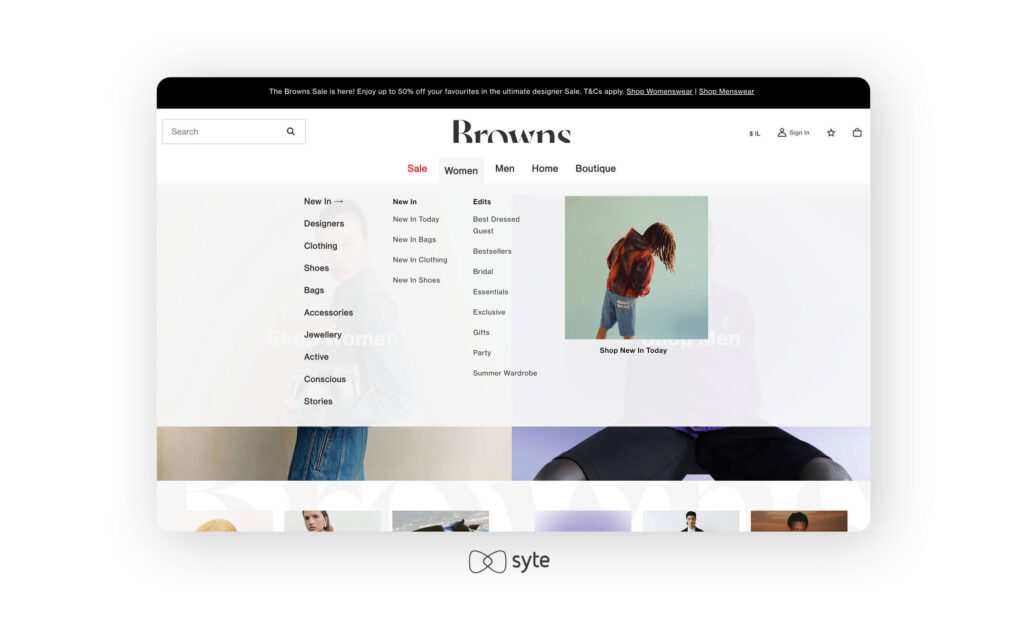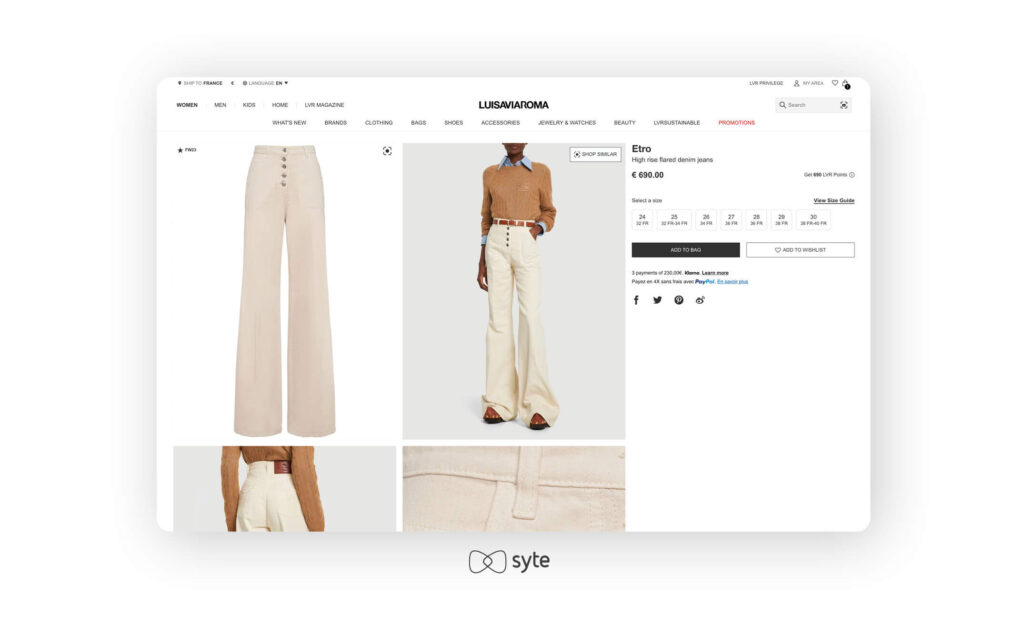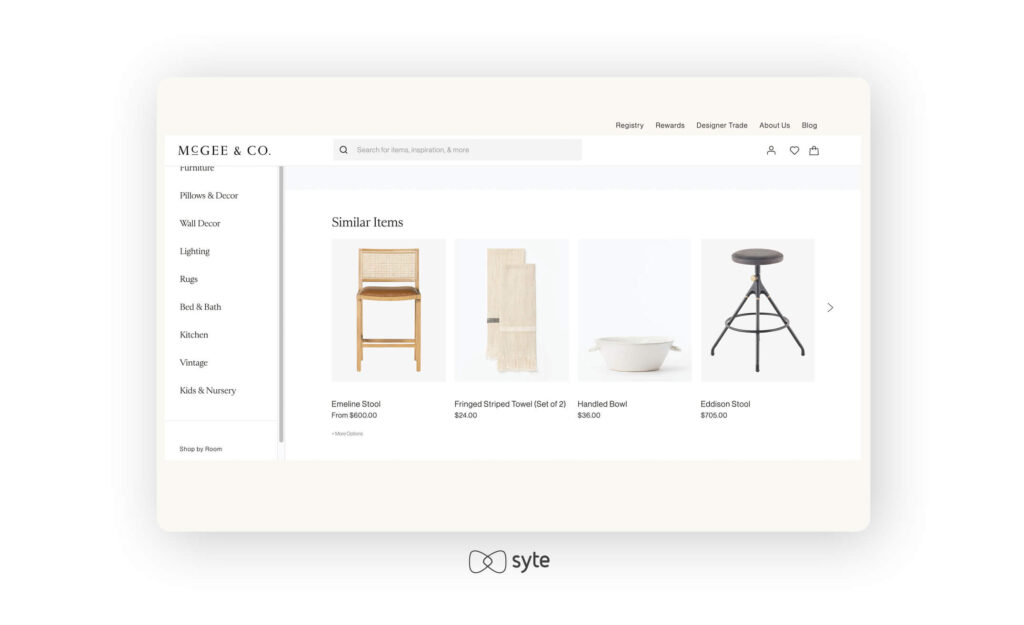Visual merchandising in brick-and-mortar shops will always be around, although many brands and retailers are opting for tech upgrades in the form of virtual dressing rooms, smart mirrors, and in-store staff equipped with tablets to search for products on-site.
Take Reformation’s tech-enabled retail concept as an example. To bring the best of online shopping to its physical stores, the sustainable fashion retailer displays one of each style on its floor to make browsing available inventory a breeze for shoppers. Touchscreen monitors are placed throughout the store so customers can build a dressing room virtually without having to lug around armfuls of clothing. Store associates call each customer to the dressing rooms once their selections are placed there. Touchscreens are also available in each dressing room so customers can order new sizes or styles without having to step out.
As in-store merchandising continues to borrow from the online world, eCommerce merchandising is also evolving, with a much-needed upgrade since the debut of online shopping in the early aughts. Both visual AI and generative AI are upgrading backend and frontend eCommerce merchandising.
On the backend, merchandisers can automate many processes such as organizing their entire product database, tagging thousands to millions of products, creating detail-rich product descriptions, assigning merchandising rules, and setting ranking and sorting strategies.
On the frontend, automated merchandising can come in the form of curated product collections, recommendation carousels, and advanced personalization powered by visual AI. Each of these areas can be automatically customized for different areas of the site, such as the homepage, product listing pages, product detail pages, and checkout screens.
All in all, backend and frontend automated merchandising helps brands and retailers to boost their business efficiencies, save valuable time and money, and provide better customer experiences.

How to Optimize Your Backend Merchandising
Product tags
The status quo:
Traditional merchandising is built on manual product tagging, which is a time-consuming and labor-intensive process. It involves the data entry of thousands to millions of products input one by one into a backend inventory management system. This often results in inaccurate, incomplete, and disorganized catalogue data.
Your merchandising upgraded:
Visual AI helps merchandisers with automatically importing and sorting large and unstructured product catalogues into a fully enriched and organized inventory database. Visual AI scans a retailer’s entire product catalogue, breaks down each element within a product image, categorizes it, and tags it with additional metadata.
The process can be performed at a large scale and in real time, ensuring consistency across continuously updated inventories. The addition of generative AI helps to automatically create specific and relevant product descriptions with thematic and subjective tags.

Merchandising rules
The status quo:
Prioritizing relevant items, collections, banners, and promotions is a manual process and often dependent on the eCommerce platform itself and code customizations undertaken by a dedicated web development team.
Your merchandising upgraded:
Automated merchandising rules begin with assigning proper tags, selecting SKUs with specific attributes (e.g., color, style, price, etc.), and creating rules based on the specific tag. Merchandising rules are specific down to the SKU level. You can promote, demote, exclude, and include specific products.
For example, if someone uploads a photo of a tee into image search, you can set merchandising rules to automatically display items at a low price point first to attract customers shopping in that price range. You can also set the parameters so users see older items first, or opt to display products deemed best sellers or top-reviewed first.
Demand forecasting
The status quo:
The lack of qualitative and contextual product metadata provides little insight into shopper behavior. This makes it difficult for brands to identify specific features, styles, or characteristics that are in high demand at a given moment.
Your merchandising upgraded:
Visual AI technology can collect and analyze vast amounts of data that provide valuable insights. Retailers can gain a deeper understanding of customer preferences, such as visual attributes like colors, cuts, and patterns, as well as popular product categories, frequently purchased items, or preferred pricing ranges. This helps merchandising teams predict supply and demand to avoid overstock and out-of-stock items and align their efforts to cater to shopper preferences.
How to Optimize Your Frontend Merchandising
Search bar
Status quo:
Baymard Institute found that 42% of eCommerce sites fail to deliver acceptable search performance for customers. This isn’t ideal, especially with customers wired to go directly to on-site search to begin the shopping journey. What’s more, textual search is limited to using the right combination of words and structured data in a retailer’s system. When consumers don’t get the correct keywords, or worse, don’t know how to describe in words what they are looking for, it creates friction, drop-off, and increased cart abandonment.
Your merchandising upgraded:
Visual AI addresses the pain point of being unable to describe products in words, enabling customers to upload pictures directly in the search bar from the homepage to turn up similar items. This helps brands supercharge searches to surface highly accurate results and encourage ongoing product discovery. You can guide shoppers to upload their pictures and find similar items with a tooltip displayed prominently on your eCommerce site.
Collections
Status quo:
To create product collections displayed through a retailer’s eCommerce site, merchandising teams must manually curate items into groups to highlight specific pieces, seasonal trends, or special deals, which can be time-consuming.
Your merchandising upgraded:
Brands can take off the burden from merchandisers by creating automated collections that align with specific customer interests and preferences — whether that’s an edit of dresses appropriate for beach weddings or a collection of exclusive products from a hyped collaboration.

Recommendations
Status quo:
Many eCommerce sites come equipped with standard, out-of-the-box recommendation engines. These built-in features are often inaccurate and provide irrelevant suggestions for shoppers, which creates drop-off and cart abandonment.
Your merchandising upgraded:
Recommendation carousels powered by visual AI are behind engines such as “Shop Similar,” “Shop the Look,” or “Shop Social.” By harnessing detailed product tags, they connect shoppers with on-point suggestions to encourage continued browsing and product discovery.
Personalization
Status quo:
There is a disparity between retailers and shoppers when it comes to personalization. 75% of marketers said they thought they provided good or excellent personalized experiences, but only 48% of consumers agree. What’s more, with GDPR, the impending death of third-party cookies, and data privacy laws, personalization based on information from individual customers is becoming increasingly difficult. It also fails to understand shoppers’ current context, often providing generic recommendations based on data gleaned from thousands of shoppers.
Your merchandising upgraded:
Advanced personalization backed by visual AI is contextual and personalizes product recommendations based on multiple shoppers’ session behavior on the website. It is based on context from webpages someone is currently viewing as compared to traditional personalization which relies on factors like demographics, location, IP address, and the like. Advanced personalization is akin to saying, “This is perfect for you,” instead of “Here’s what thousands of other customers who are somewhat similar to you bought.”
Raising the Bar for eCommerce Merchandising
Innovation is the crux of merchandising whether for brick-and-mortar shops or eCommerce platforms. The next chapter in online merchandising lies in visual AI and generative AI to make the product search and discovery experience more efficient for new and existing customers.